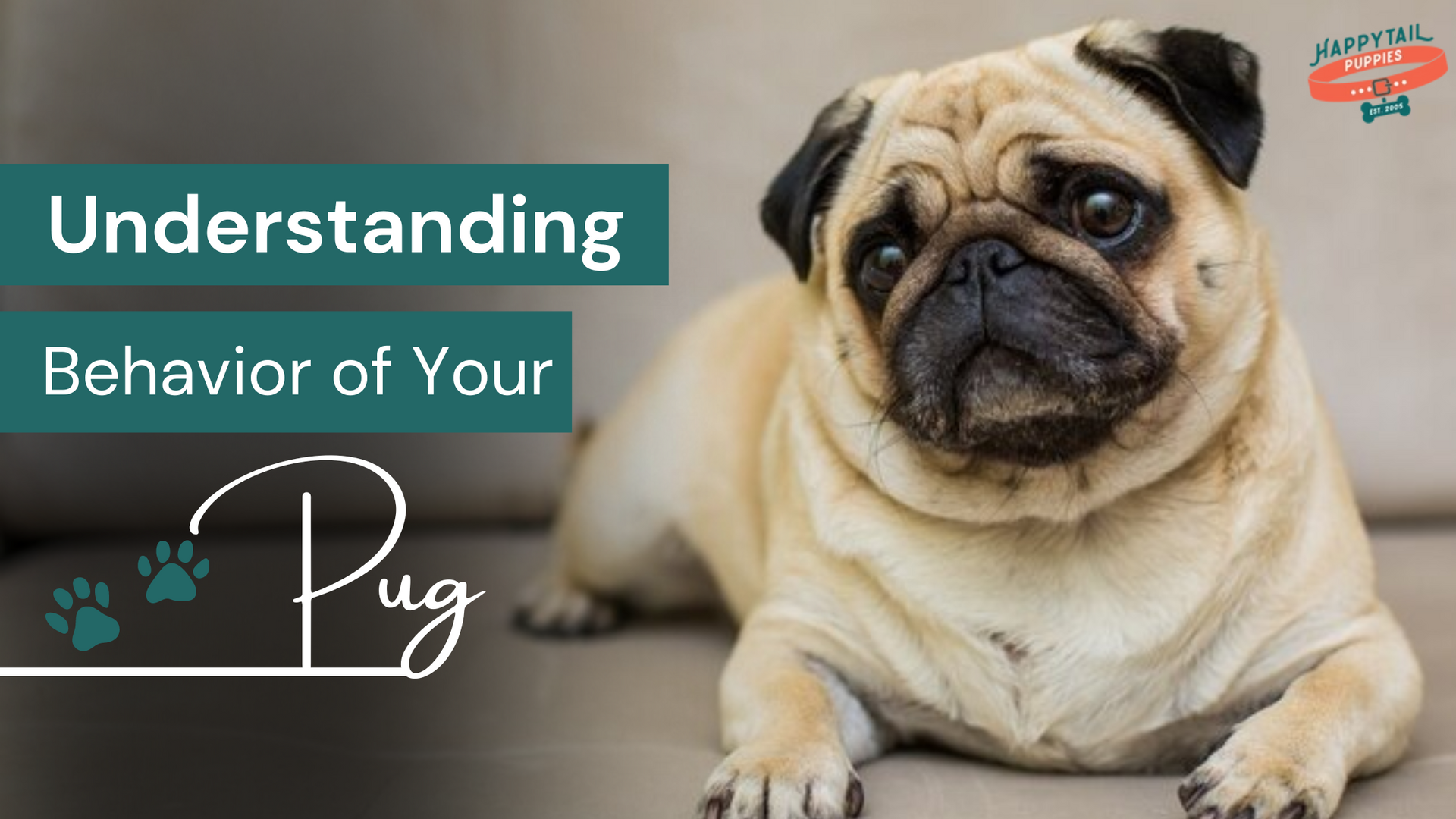Last Updated on September 24, 2025 by Emily Hartman
Imagine a world where you and your furry friend understand each other perfectly. Sounds like a dream, right?
But what if I told you it’s possible? Every wag, bark, and tilt of the head is your dog’s way of communicating with you. But do you really know what your pup is trying to tell you? Misunderstanding these signals can lead to frustration for both you and your pet.
By unlocking the secrets of dog behavior, you can strengthen your bond and become the best of friends. Keep reading to uncover the hidden messages behind your dog’s actions and transform your relationship forever. Trust me, you won’t want to miss what’s coming next!

Credit: happytailpuppies.com
Contents
Body Language Signals
Dogs communicate through body language, revealing their emotions and needs. A wagging tail might show happiness or excitement. Raised fur or a tucked tail can indicate fear or anxiety. Understanding these signals helps build a stronger bond with your furry friend.
Understanding your dog’s body language is like learning a new language. It’s fascinating to decode what your furry friend is trying to convey through wagging tails, ear positions, and more. By paying attention to these signals, you can build a stronger bond with your pup and address their needs more effectively.Ear Positions
Your dog’s ears can say a lot about their mood. If the ears are upright and facing forward, your pup is likely alert and curious. When the ears are laid back, they might be feeling anxious or submissive. It’s interesting to note how different breeds have unique ear shapes, which can affect how they communicate. Do your dog’s ears perk up when you mention their favorite toy? That’s a clear sign of excitement and eagerness.Tail Wagging
Tail wagging doesn’t always mean your dog is happy. The speed and direction of the wag can indicate different emotions. A slow wag with a broad sweep usually means a relaxed, friendly demeanor. However, a high, stiff wag may signal tension or aggression. Observing how your dog wags their tail in different situations can help you understand what they’re feeling.Eye Expressions
Your dog’s eyes are windows to their soul, revealing emotions like excitement or fear. Soft, relaxed eyes show contentment and comfort. On the other hand, wide eyes with visible whites might mean your dog is scared or stressed. Have you ever noticed how your dog gives you a long gaze during cuddle time? That’s their way of showing affection and trust. Paying attention to eye expressions can deepen the connection between you and your dog.Body Posture
The way your dog holds their body can tell you a lot about their emotional state. A relaxed posture with a wagging tail often indicates happiness. Conversely, a stiff body with a lowered head may suggest discomfort or fear. Have you seen your dog crouch low with their tail tucked between their legs during a thunderstorm? This posture often signals anxiety. By recognizing these cues, you can comfort your dog when they need it most.Paw Lifting
Lifting a paw can be more than just a trick. Sometimes, it signals uncertainty or a request for attention. If your dog lifts their paw while looking at you, they might be asking for reassurance or play. It’s fascinating how something as simple as a paw lift can communicate so much. Next time your dog lifts a paw, consider what they might be asking or feeling. Understanding these body language signals can transform your relationship with your dog. What surprising gestures have you noticed in your pup? By being attentive to these cues, you can ensure your dog feels understood and loved.
Credit: prettiestpuppies.com
Vocalizations And Their Meanings
Understanding what your dog is saying can deepen your bond. Dogs use vocalizations to communicate with humans and other animals. These sounds range from barks to whines, each carrying a distinct message. Recognizing these signals can help you respond to your pup’s needs effectively.
What Does Barking Mean?
Barking is a dog’s way of getting attention. It can mean excitement, warning, or demand. A high-pitched bark often signals playfulness. Low, continuous barking may indicate a threat. Listening to the tone and frequency helps determine the reason behind the bark.
Decoding Whines
Whining usually expresses discomfort or anxiety. Your dog might whine when hungry or in pain. A soft whine can also mean seeking comfort or attention. Observing the situation helps identify the cause of whining.
Understanding Growls
Growls can sound intimidating. They often signal a warning or discomfort. A playful growl is different from an aggressive one. The context and body language reveal the growl’s meaning. Knowing these can prevent misunderstandings.
Significance Of Howling
Howling is a form of long-distance communication. Dogs howl to express loneliness or respond to certain sounds. Some breeds howl more than others. Recognizing the triggers can help manage excessive howling.
The Meaning Behind Yipping
Yipping is a short, high-pitched bark. It often indicates excitement or a call for play. Puppies yip more often than older dogs. Observing their behavior during yipping helps understand their needs.
Common Behavioral Issues
Understanding your dog’s behavior can be challenging. Dogs communicate through actions and sounds. Recognizing these signals helps in addressing behavioral issues. These issues often arise from unmet needs or environmental stressors. Addressing them promptly can improve your pet’s quality of life. Let’s explore some common behavioral issues in dogs.
Excessive Barking
Dogs bark to communicate. Excessive barking may indicate boredom or anxiety. It can also be a response to external stimuli. Training can reduce unnecessary barking. Establishing a routine helps in managing this behavior.
Destructive Chewing
Dogs chew to explore their surroundings. Destructive chewing signals stress or insufficient exercise. Providing chew toys can redirect this behavior. Ensuring adequate physical activity prevents boredom-induced chewing.
Separation Anxiety
Dogs may feel anxious when left alone. Signs include pacing or destructive behavior. Gradual desensitization helps in alleviating anxiety. Providing a safe space can comfort your pet during your absence.
Aggression
Aggressive behavior in dogs can be alarming. It may stem from fear or protective instincts. Identifying triggers is crucial in managing aggression. Professional training can aid in controlling aggressive tendencies.
Digging
Digging is a natural instinct for dogs. It can signal boredom or a desire to escape. Providing a designated digging area can satisfy this urge. Engaging your dog in activities reduces unwanted digging.
Tips For Effective Communication
Effective communication with your dog is key to understanding their behavior. Dogs use body language and sounds to express feelings and needs. Learning to interpret these signals helps strengthen your bond. It also ensures your pup feels understood and secure. Below are some tips to enhance communication with your furry friend.
Recognize Body Language
Watch for signs like wagging tails or raised fur. A wagging tail often indicates happiness. Raised fur might signal fear or aggression. Understanding these cues helps you respond appropriately.
Pay Attention To Vocalizations
Barks, whines, and growls convey different messages. A bark can mean excitement or alertness. Whining might indicate discomfort or a need for attention. Growls often signal a warning. Listening carefully helps you interpret these sounds.
Maintain Eye Contact
Eye contact builds trust and rapport. Dogs often look into your eyes for guidance. Avoid staring as it can be intimidating. Gentle eye contact reassures your dog.
Use Consistent Commands
Consistency in commands aids learning. Use simple words like “sit” or “stay.” Repetition helps your dog understand and follow instructions. Avoid changing commands frequently.
Reward Positive Behavior
Positive reinforcement encourages good behavior. Give treats or praise when your dog obeys commands. This motivates them to repeat desired actions. Rewards strengthen your bond and communication.
Be Patient And Calm
Patience is crucial in effective communication. Dogs sense your emotions. Staying calm helps your dog feel relaxed. Avoid shouting or showing frustration.
Understand Personal Space
Respect your dog’s personal space. Not all dogs enjoy hugs or close contact. Give them room to move freely. This respect helps them feel safe and comfortable.

Credit: www.instagram.com
Frequently Asked Questions
Why Does My Dog Bark So Much?
Dogs bark to communicate. It might mean excitement, warning, or a need for attention.
What Does Tail Wagging Mean In Dogs?
Tail wagging often shows happiness. But the speed and direction can mean different emotions.
How Can I Tell If My Dog Is Anxious?
Signs include pacing, whining, or hiding. Look for changes in behavior or body language.
Why Does My Dog Lick Me?
Licking can show affection. Sometimes it’s a way to explore tastes or scents too.
Is My Dog Trying To Tell Me Something By Whining?
Whining usually signals stress, pain, or a need. Pay attention to the context and situation.
Conclusion
Understanding your dog’s behavior builds a stronger bond. Dogs express feelings through actions. Joy, fear, or confusion. Each gesture tells a story. Watch their body language closely. Listen to their barks and whines. These are their words. Respond with kindness and patience.
They need love and guidance. Learn what your pup wants to say. It brings happiness to both of you. This connection enriches your life. A happy pup means a happy home. Keep observing and learning every day. You’ll be amazed at what you discover.
Your furry friend has so much to share.

Emily Hartman is a lifelong dog lover, writer, and canine care enthusiast. With years of experience in pet parenting and a deep passion for helping others raise happy, healthy dogs, she shares practical tips, thoughtful advice, and product recommendations to make life better for pups and their people. When she’s not writing, you’ll find her hiking with her rescue lab, Milo, or exploring new dog-friendly spots around town.

